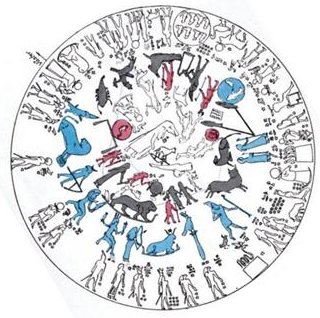Pare in Ha10-31 has been mentioned at honui. With 3 glyphs per day glyph number 240 will be at the end of day 80, or if we add 64 - at the end of day 144 (= 8 * 18):
Instead of counting with 3 glyphs per day, though, I would rather prefer to count each glyph as a day, which gives 240 + 64 = 304, i.e. 4 days beyond day 300 counted from winter solstice. Alternatively we could count with 2 glyphs per day and reach 240 / 2 = 120 = 5 * 24 (as in Ha5-24). Then after adding 64 we will reach to day 184, which is in agreement with midsummer (364 / 2) at honui in Ha5-22. The difference between the results of the two methods appears to be 4 months. Depending on the points of measurement, however, we can choose these 4 months to be for instance 30 days long or 29½ days long: (304 - 184) / 4 = 30 = (300 - 180) / 4 (302 - 184) / 4 = 29½ = (300 - 182) / 4 (472 - 360) / 4 = 28 It is possible to create an inserted 4 months period between midsummer and Te Pei by different methods. In H a difference between 16 and 12 months has apparently been encoded by the numbers, while in G the message has been made more explicit:
If we begin to count the new year from Rogo in Gb6-26, then there are 184 days up to his next appearance at summer solstice. And hanau in Gb1-2 must be included in the lunar measure 177 days - it is also natural to have 'birth' at the beginning rather than at the end. But then there will be only 111 days for those 'extra' 4 months (which we can imagine refer to Nga Kope Ririva, the 3 islets which did not belong to Hau Maka but to Te Taanga. These 'youths' (kope) are 'standing in the water' (tutuu vai), an expression which not only refers to the visible truth outside the southwest corner of the island, but which also could correspond to the 'extra' 111 glyphs, because they arrive after the first 184 days (which maybe are representing the homeland of Hotu Matua). 111 + 177 + 184 = 472. The kuhane of Hau Maka does not arrive until Rogo has left (Ga5-10). If we insert a 'leap day' (not to be counted), then 177 + 183 = 360. In Q the 'great hole' is in pare (*Qa2-40), in G it comes with Gb1-3 (the 2nd day of those 177 and beyond the 4 inserted special months). 99 days later another 'great hole' arrives. These 2 'great hole' glyphs presumably illustrate Rogo without 'vision' (a glyph joke, because the great hole is a mata, i.e. 'eye'). The hole is in the center of his body, which presumably means in the middle of his cycle (at 'the belly of the Sun' like a great navel). In H the hole is in honui (Ha5-22), and 5 ('fire') together with 22 spells 'end of Spring Sun'. The cyclope Polyphemus (son of Poseidon) used a huge doorstone to 'plugg' the mouth of his cave, and so huge was it that it weighed more than 22 wagons could carry: ... He bore a grievous weight of dry wood, which he cast down with a din inside the cave, so that in fear all fled to hide. Lifting a huge doorstone, such as two and twenty good four-wheeled wains could not have raised from the ground, he set this against the mouth of the cave, sat down, milked his ewes and goats, and beneath each placed her young, after which he kindled a fire and spied his guests ... Myth has much to tell about a stone covering an opening. The entity balancing precariously on top of hau tea in Ha5-24 (where presumably the 24 halfmonths of spring are over) could be the 'doorstone', it is huge enough to cover the 'navel hole' of honui. In Ha5-20 tagata has lost his head (and with it of course his eyes). Glyph number 236 probably refers to Te Pei, the dark place after 8 * 29.5 days. Maybe day 236 alludes to the blind giant Orion (Polyphemus). If so, then Te Pou and Hua Reva should follow, which we possibly can read also in the round zodiac of Dendera:
Te Pou could be the pole upon which a bird is perching (solstice) and Hua Reva could be the uplifted Sothis cow hanging (reva) in the sky. Perhaps the constellation Puppis, therefore, is Hua Reva. Puppis is low in the 'water' but at this time of the year higher than otherwise. We need more pages in order to compare G, H, Q, and the Dendera zodiac. |
||||||||||||||||||||||||||||||||||||||||||||||||









